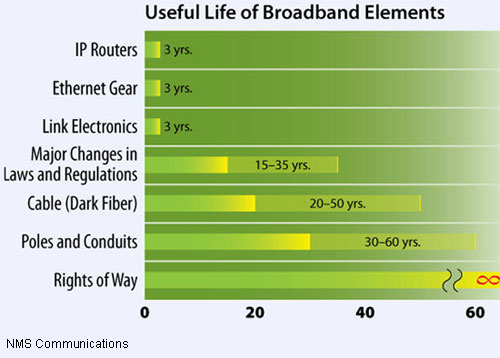


|
||
|
||
Network Neutrality is a hot topic in the US. The FCC held hearings in my neighborhood recently (while I was in Asia). Now I see Professor Susan Crawford will be testifying next Tuesday at a House Judiciary Committee hearing on “Net Neutrality and the First Amendment.” I look forward to her remarks, but I worry that the whole discussion will be focused on “IP Pipes,” that is connectivity at network layer 3. This distracts us from the fundamental problem. Imposing network neutrality is patching an obsolete regulatory system. We must be careful what we ask for. Despite the best of intentions, laws and regulation can easily produce unexpected results, as I’ve discussed here & here & here.
More importantly, laws and regulation evolve slowly with major changes taking years, even decades, so it’s critical to understand first principles and what makes sense for the long term.
Consider the useful life of various network elements involved in fixed broadband connectivity.

This diagram says a lot about what can be efficiently regulated and where one would prefer competition. Notice the logical dividing point is NOT at layer 3—IP Routers. It’s at layer zero—Dark Fiber.
This suggests a regulated dark fiber provider and multiple competitive providers of access, connectivity and other services, operating above the dark fiber layer.
Is there a natural monopoly, and if so, where?
Local rights-of-way (ROW) are a bottleneck. Whether they are owned by the state, the municipality or a neighborhood association, or are deeded arrangements between adjacent property owners, local rights-of-way are a limited resource. Installing poles and conduits in these rights of way results in visual blight and/or construction mess, of concern to the owners of the rights-of-way. And a given set of conduits holds a limited number of cables, although each cable may have very many fibers.
Between major US cities, we find competing cables in competing rights-of-way and a vibrant market where dark fiber strands are available as well as every conceivable higher level service. That’s not the case in front of my house where there is just one city-owned street and one customer (me), or in the “middle mile” between my neighborhood and the nearest major communications hub where there are a limited number of routes and a limited market (me plus my neighbors). So, at least for local and middle mile dark fiber, some kind of communal, condominium, municipal or regulated monopoly provider makes sense. But above that level?
Certainly telephony is not a natural monopoly. Just look at long distance and VoIP pricing. The only place where telephony has significant per-minute cost is where it’s been granted a statutory monopoly.
Lighting the fiber need not be a natural monopoly
A fiber is only useful once it’s lite, but the person or company that lites it has the potential to control what goes over the fiber, a distinct problem if there’s only one dark fiber per home. There are at least two solutions:
With option 1, all homes get the same speed electronics and are likely to be locked at that speed until the whole neighborhood is upgraded, perhaps years after the technology becomes available.
With option 2, each home owner gets to select a service provider and the speeds and services they desire.
Which would you personally prefer? Which would you like to see adopted in the US?
What’s happening in the rest of the world
1. Condominium fiber. Developers, or contractors working with groups of interested parties, lay fibers and sell individual fibers on a condominium basis. There’s a good overview of the subject here [PDF] and there are success stories like these from Quebec.
2. Municipal dark fiber. The government organizes fiber deployment, making dark fiber available to all comers. Stokab AB in Stockholm is a very successful example of this model.
Dark fiber is no more complex for the homeowner or businessman. They need only select an ISP to light their fiber. The point is to make it easy for many, many providers to compete to offer services to individuals and businesses using the latest and greatest electronics.
Is anything like this possible in the US?
We have an existing, highly obsolete, regulatory system in place and therefore many vested interests, but if we can articulate the desired end goal, the compelling reasons why it makes sense and proof points like broadband in Sweden, anything is possible.
I’ll be speaking on this subject at eComm 2008 next week (that’s in addition to my panel on Wireless Innovation) and I expect to be discussing these subjects the week after in the Unconference track at Spring VON. If you will be at either event, please join in.
Sponsored byVerisign

Sponsored byVerisign

Sponsored byIPv4.Global

Sponsored byDNIB.com

Sponsored byWhoisXML API

Sponsored byCSC

Sponsored byRadix
